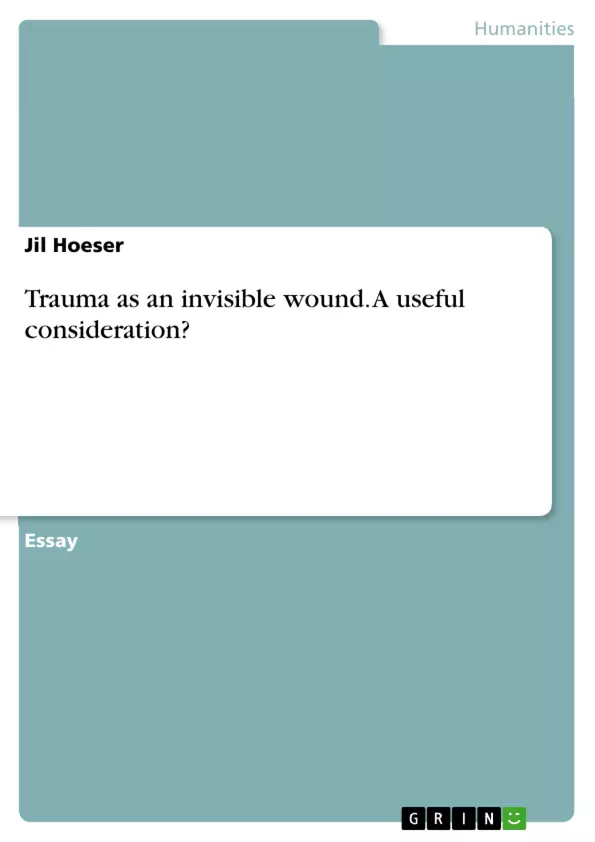In the present work, I will try to find an answer to whether trauma can be defined as an invisible wound or not. Trauma can be caused by different kinds of things and can happen to everyone: Not only firemen or policemen can be traumatized by what they have to deal with at work, trauma can also be caused by sexual abuse, wars, accidents and so on. Thus, a combat veteran can associate the sound of a helicopter with a horrifying battle experience or a survivor of a bad train crash can identify the sound of a locomotive with the trauma of the crash.
This already leads us to possible consequences of a traumatic experience, called posttraumatic stress disorder or simply PTSD. In the following paragraphs, I will try to set up a general definition of trauma, see how the body and soul react to traumatic experiences and how a trauma can be expressed. After that, I will analyse Wolfgang Borchert’s short story Die Küchenuhr, an after-war story about the bombings in Hamburg. I will try to see parallels between the theoretical part of this essy and the short story, in order to answer the main question of this essay, whether trauma can be considered as an invisible wound or not.
Inhaltsverzeichnis (Table of Contents)
- In your opinion, how useful is it to consider a trauma as an,invisible wound'?
- Definition and Characteristics of Trauma
- Trauma as an Invisible Wound: A Theoretical Perspective
- The Impact of Trauma: Symptoms and Consequences
- Trauma and the Body: Physical and Psychological Manifestations
- The Short Story Die Küchenuhr: A Case Study
- Conclusion: Trauma as an Invisible Wound
Zielsetzung und Themenschwerpunkte (Objectives and Key Themes)
This essay aims to examine the concept of trauma as an invisible wound. It explores the definition, characteristics, and consequences of trauma, drawing upon both theoretical frameworks and a literary case study.
- Defining Trauma: Exploring its Nature and Impact
- The Invisible Nature of Trauma: The Psychological and Physical Effects
- The Impact of Trauma on the Body and Mind: Symptoms and Consequences
- Posttraumatic Stress Disorder (PTSD): A Common Response to Trauma
- The Role of Memory and Avoidance in Trauma Processing
Zusammenfassung der Kapitel (Chapter Summaries)
- In your opinion, how useful is it to consider a trauma as an,invisible wound'? This introductory chapter sets the stage for the essay by posing the central question and outlining the scope of the discussion.
- Definition and Characteristics of Trauma: This chapter delves into the definition of trauma, exploring its etymological roots, medical and psychological perspectives, and the criteria for identifying a traumatic event.
- Trauma as an Invisible Wound: A Theoretical Perspective: This chapter examines the theoretical underpinnings of trauma, focusing on the concept of trauma as an invisible wound and its implications for understanding the psychological and physical effects of traumatic experiences.
- The Impact of Trauma: Symptoms and Consequences: This chapter explores the various symptoms and consequences of trauma, including posttraumatic stress disorder (PTSD), emotional numbing, intrusive thoughts, avoidance behaviors, and hyperarousal.
- Trauma and the Body: Physical and Psychological Manifestations: This chapter examines the physical and psychological manifestations of trauma, highlighting how traumatic experiences can impact the body and mind.
- The Short Story Die Küchenuhr: A Case Study: This chapter analyzes Wolfgang Borchert's short story Die Küchenuhr, using it as a case study to illustrate the concept of trauma as an invisible wound and its literary representation.
Schlüsselwörter (Keywords)
The key terms and concepts explored in this essay include trauma, invisible wound, posttraumatic stress disorder (PTSD), psychological impact, physical manifestations, emotional numbing, intrusive thoughts, avoidance behaviors, hyperarousal, memory, and literary representation.
- Quote paper
- Jil Hoeser (Author), 2016, Trauma as an invisible wound. A useful consideration?, Munich, GRIN Verlag, https://www.grin.com/document/316414



